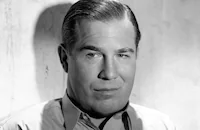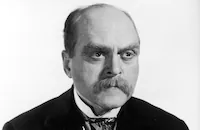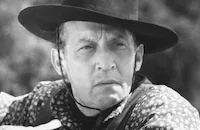6,000 Enemies

Brief Synopsis
Cast & Crew
George B. Seitz
Walter Pidgeon
Rita Johnson
Paul Kelly
Nat Pendleton
Harold Huber
Film Details
Technical Specs

Synopsis
Steve Donegan, a politically ambitious prosecuting attorney, is framed for bribery by his nemesis, crime boss Joe Silenus. Steve is sentenced to prison where he again meets all the men he has convicted in his anti-crime crusade. Prison doctor Malcolm Scott warns Warden Parkhurst that Steve will be a marked man by his six thousand enemies, but the ineffectual warden refuses to offer Steve special protection. When an inmate tries to stab Steve, Anne Barry, a woman he convicted of embezzlement, saves his life by warning the guards with her screams. As Steve suffers the abuse of his fellow prisoners, his brother Phil begins to tail Silenus, determined to prove Steve's innocence. One day, while Steve is fixing a pipe in the prison laundry, he talks to Anne and, realizing that she too, was framed by Silenus, offers to help prove her innocence. After Steve is again brutally attacked by the inmates, Dr. Scott suggests that he can win their respect by meeting prison tough guy "Socks" Martin in the boxing ring. Steve is soundly beaten by Socks, but wins the convicts' admiration through his courage. Socks then warns Steve that he is marked for death and advises him to join a planned prison break. Soon afterwards, Phil is murdered by Silenus' men outside the prison gates as he is coming to visit his brother, and the gun shots trigger the prison break. Enraged by his brother's murder, Steve plans to escape, but after the convicts take Dr. Scott hostage, Anne convinces Steve to prevent the break by pumping steam into a passageway leading to the unguarded back gate. With the evidence that Phil uncovered, Steve is exonerated, and he returns to his post of district attorney to clear Anne and send Silenus to the electric chair.

Director
George B. Seitz
Cast

Walter Pidgeon

Rita Johnson

Paul Kelly

Nat Pendleton

Harold Huber

Grant Mitchell

John Arledge

J. M. Kerrigan
Adrian Morris

Guinn Williams
Arthur Aylesworth

Raymond Hatton
Lionel Royce

Tom Neal
Willie Fung
Helena Phillips Evans
Esther Dale
Selmer Jackson
Ernest Whitman
Mitchell Lewis
Frank Lackteen
Bernadene Hayes
Robert Emmett Keane
George Guhl
Tom Collins
Phil Tead
Truman Bradley
George Taylor
Harry Tenbrook

Wilfred Lucas
Olaf Hytten
Sarah Edwards
Horace Macmahon
Bruce Mitchell
Larry Mcgrath

James Flavin
Jack Mulhall
Frederik Vogeding
Nell Craig
Ben Hall
Drew Demorest
George Magrill
Ernie Adams
Harry Tyler
William Worthington
Louis Natheaux
George Melford
John Webb Dillion
Crew
Peter Ballbusch
Amelia Batchelor
Bill Calihan
Daniel B. Cathcart
Howard Culver
Major R. Cup
Ray Finney
Cedric Gibbons
Irving Glassberg
Lewis Gomarkas
Bill Greenwald
Lucien Hubbard
Charles J. Hunt
Lloyd Isabell
Al Jennings
Kerner Kemp
Gilbert Kurland
Wilmon Menard
Bertram Millhauser
Wilmon Minard
Conrad Nervig
Howard Roberts
Charles Ryan
John Seitz
Wes Shanks
Douglas Shearer
Leo Stanley
William Strong
Dolly Tree
Edward Ward
John Waters
Edwin B. Willis

Film Details
Technical Specs

Articles
6000 Enemies -
Here the formula gets a bit of a twist for the story of Steve Donegan (Walter Pidgeon), an all-too-efficient district attorney framed on charges of bribery. Sent behind bars, he finds himself among the titular enemies, a huge sum of whom he put in the slammer in the first place; there he must prove himself through violent confrontations, dodge prison riots, and unlock the reason he's there, which seems to be tied to another framed innocent, Anne (Rita Johnson).
The primary modern claim to fame for this brief (just over one hour) programmer is that central fight scene, which many have noticed as the primary inspiration for a similar sequence in Cool Hand Luke (1967). The film also marked the third of five teamings with Pidgeon and Johnson, who had first appeared together in My Dear Miss Aldrich (1937) and also teamed up for Man-Proof (1938) (from which Johnson was excised from the final cut), Nick Carter, Master Detective (1939), and Stronger Than Desire (1939).
As was customary at the time, 6000 Enemies was mounted very quickly with a screenplay by Bertram Millhauser turned into MGM on March 15, 1939. By June 9 the film was in theaters, competing for the action-hungry audiences Warner Bros. had skillfully cultivated throughout the decade.
Of course, the main attraction here is Walter Pidgeon, who also headlined as an attorney the same year in Society Lawyer. With well over a hundred films to his credit by the time he retired in 1977, the Canadian-born actor went under contract to MGM in 1937 and remained there until 1956, with occasional loan outs most notably including How Green Was My Valley (1941).
A classically trained singer, Pidgeon studied both law and acting (ironically enough) at the University of New Brunswick and got his start on the Broadway stage in the mid-1920s. It wasn't until the 1940s that he really came into his own as an actor with multiple Oscar nominations and a string of popular appearances with Greer Garson, ultimately totaling nine films including such classics as Mrs. Miniver (1942), Madame Curie (1942), and Blossoms in the Dust (1941). His post-Garson work continued to thrive, including roles in the sci-fi favorites Forbidden Planet (1956) and Voyage to the Bottom of the Sea (1961) as well as the musical classic Funny Girl (1968). Fans of those films will no doubt be startled to see Pidgeon here in a tougher role than usual, slugging his way to respectability among throngs of tough-as-nails convicts; however, that versatility is what earned him a permanent spot in Hollywood and inspired performances still powerful and effective today.
By Nathaniel Thompson

6000 Enemies -
Quotes
Trivia
Notes
According to the George B. Seitz papers contained in the AFI library, Paul Hurst was originally selected for the role of Bull Snyder. According to a news item in Hollywood Reporter, nineteen-year old concert pianist Dorothy Humel was to have made her motion picture debut, however, her participation in the released film has not been confirmed.















